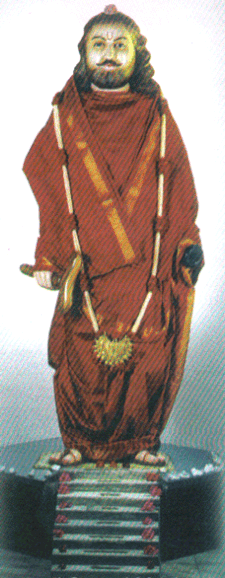মৎস্যেন্দ্ৰনাথ
মৎস্যেন্দ্ৰ বা মৎস্যেন্দ্ৰনাথ, (পূৰ্ব দহ শতিকা) হিন্দু আৰু বৌদ্ধ ধৰ্মৰ এগৰাকী সাধু আৰু যোগী আছিল। ঐতিহাসিকভাৱে তেওঁক হঠ যোগ আৰু বহু সংখ্যক পুৰণি গ্ৰন্থৰ লেখক হিচাপেও জনা যায়। তেওঁক নাথ সম্প্ৰদায়ৰ প্ৰতিষ্ঠাতা সকলৰ মাজৰে এজন বুলিও কোৱা হয়৷[4] তেওঁ বিশেষকৈ কৌল শৈৱ ধৰ্মৰ সৈতে সংযুক্ত।[5] তেওঁক ৮৪ মহাসিদ্ধৰ মাজৰ এজন বুলি ধৰা হয় আৰু গোৰক্ষনাথৰ গুৰু বুলি জনা যায়। মীননাথক হিন্দু আৰু বৌদ্ধ উভয় ধৰ্মৰে সাধু বুলি কোৱা হয়। কোনো কোনোৱে তেওঁক অবলোকিতেশ্বৰৰ অৱতাৰ বুলি বিশ্বাস কৰে।[উদ্ধৃতিৰ প্ৰয়োজন]
| মৎস্যেন্দ্ৰনাথ | |
|---|---|
 মৎস্যেন্দ্ৰ বা মৎস্যেন্দ্ৰনাথ | |
| জন্ম | ১০ শতিকা কামৰূপ[1][2][3] |
| প্ৰতিষ্ঠাপক | হঠ যোগ |
| Sect associated | নাথ, কাউলা, শৈৱ ধৰ্ম |
| দৰ্শন | হঠ যোগ, যোগ |
| কৌলজ্ঞান নিৰ্ণয়, অকুল বীৰতন্ত্ৰম্[2] | |
জন্মস্থান
সম্পাদনা কৰকতেওঁৰ জন্মস্থান সম্বন্ধে বিভিন্ন কিম্বদন্তি পোৱা যায়।[6] তিব্বতৰ সৈতে যুক্ত মৎস্যেন্দ্ৰনাথ যাক অবলোকিতেশ্বৰৰ অৱতাৰ বুলি ধৰা হয়, তেওঁ কামৰূপৰ এটা মছুৱৈ পৰিয়ালৰ সদস্য আছিল। তেওঁক কেৰেলাৰ ত্ৰিক্কানন্দ ত্ৰয়ম্বকেশ্বৰ মন্দিৰৰ পিছফালৰ মছুৱৈ সম্প্ৰদায়ৰ মাজত পোৱা গৈছিল।[1][2][7] [8][9] অন্য এক সূত্ৰই তেওঁৰ জন্মস্থান উত্তৰ বংগ বুলি কৈছে।[2][3] মীননাথৰ ৰথ যাত্ৰা অনুষ্ঠিত হোৱা নেপালৰ বুঙমাটিৰ নেৱাৰী কলনীত উদ্ধাৰ হোৱা শিলালিপিত তেওঁৰ মূৰ্তি অসমৰ পৰা অনা হৈছিল বুলি উল্লেখ আছে। চবৰতন্ত্ৰৰ উল্লেখ মতে তেওঁ ২৪ গৰাকী কপালিকা সিদ্ধৰ অন্যতম আছিল।[1]
লুই-পা
সম্পাদনা কৰকবহুতো আধুনিক পণ্ডিতে মৎস্যেন্দ্ৰনাথৰ সৈতে লুইপাদক চিনাক্ত কৰিবলৈ চেষ্টা কৰিছে।[10] তেওঁলোকৰ মাজত কেইবাটাও সাদৃশ্য আছে। তেওঁলোকৰ দুয়োটা নাম লুই আৰু মীন মানে মাছ।[10] শ্ৰীলংকা আৰু পূব ভাৰত আৰু অসমত দুয়োগৰাকীয়ে যোগিনী তন্ত্ৰৰ লুইপা সম্বৰ আৰু মীননাথ যোগিনি-কৌলা আদিৰ প্ৰৱৰ্তক আছিল। লুইপাক আদিসিদ্ধ বুলি গণ্য কৰা হয় আৰু মৎস্যেন্দ্ৰনাথক আদিগুৰু বুলি কোৱা হৈছিল। কিন্তু, যদি লুইপাৰ জন্ম খ্ৰীষ্টপূৰ্ব অষ্টম শতিকাত হয়, তেন্তে তেওঁক মৎস্যেন্দ্ৰনাথৰ সৈতে চিনাক্ত কৰিব নোৱাৰি। কাৰণ মৎস্যেন্দ্ৰনাথ খ্ৰীষ্টীয় নৱম-দশম শতিকাৰ আছিল।[11]
উল্লেখযোগ্য ৰচনা
সম্পাদনা কৰকমৎস্যেন্দ্ৰনাথক হঠ আৰু তান্ত্ৰিক ৰচনাৱলীৰ কৃতিত্ব প্ৰদান কৰা হয়। তেওঁক 'কৌলজ্ঞান নিৰ্ণয়'[12], 'মৎস্যেন্দ্ৰসংহিতা', আৰু 'অকুলবীৰতন্ত্ৰম্'ৰ দৰে সংস্কৃত গ্ৰন্থৰ ৰচক বুলি কোৱা হয়।[2]
তথ্য উৎস
সম্পাদনা কৰক- ↑ 1.0 1.1 1.2 "Asiatic Society (Calcutta, India)". Journal and Proceedings of the Asiatic Society of Bengal খণ্ড XXVI (1): 133–141. 1930.
- ↑ 2.0 2.1 2.2 2.3 2.4 Suhas Chatterjee (1998), Indian Civilization and Culture, P.441 Vajrayana Buddhist cult flourished in Kamarupa in the 10th century. It is locally known as Sahajia cult. The celebrated Buddhist monk Minannatha of Tibet happeneed to be a son of a fisherman of Kamarupa. However, some scholars say that Minanatha was a native of Bengal. Another monk in Tibet, Rahula was an Assamese from Kamarupa. Akulaviratantra, a text on tantra worship was compiled by Minanatha.
- ↑ 3.0 3.1 Feuerstein, Georg (2013-09-11). The Yoga Tradition: Its History, Literature, Philosophy and Practice (Kindle Locations 12785-12786). Hohm Press. Kindle Edition. "Hindu tradition associates the creation of Hatha- Yoga with Goraksha Nâtha (Hindi: Gorakhnâth) and his teacher Matsyendra Nâtha, both of whom were born in Bengal."
- ↑ Feuerstein, Georg (2013-09-11). The Yoga Tradition: Its History, Literature, Philosophy and Practice (Kindle Locations 12788-12789). Hohm Press. Kindle Edition. "Matsyendra was a chief representative, if not the originator, of what is known as Nâthism. But Shiva himself is considered as the source of the Nâtha lineage and is invoked as Adinâtha or 'Primordial Lord.'" (Kindle Locations 12825-12827). "Using his third eye, Shiva gazed straight through the mountain of flesh into the fish’s stomach, where he saw Mina. He was thrilled at the discovery, saying, “Now I see who my real disciple is.” Turning to his sleepy spouse, he said: “I will initiate him rather than you.”"
- ↑ Feuerstein, Georg (2013-09-11). The Yoga Tradition: Its History, Literature, Philosophy and Practice (Kindle Locations 12803-12804). Hohm Press. Kindle Edition. "He is specifically associated with the Kaula sect of the Siddha movement, within which he may have founded the Yoginî-Kaula branch."
- ↑ The Alchemical Body: Siddha Traditions in Medieval India" by David Gordon White, p. 91
- ↑ Kamrupa Anusandhana Samiti (1984), Readings in the History & Culture of Assam,p.201 it is stated that a Siddha, named Minanatha, was a fisherman from Kamarupa
- ↑ Institute of Nepal and Asian Studies, Tribhuvan University, Nepal (1996), Contributions to Nepalese Studies - Volumes 23-24,Page 93 Matsyendra was a resident of Kamrup-Kamakhya (today's Assam in East India).
- ↑ Pandit, M. M.; Shastri, H. P.. Bauddha Gan O Doha.
- ↑ 10.0 10.1 Dasgupta, Shashibhusan (1995). Obscure Religious Cults, Firma KLM, Calcutta, আই.এচ.বি.এন. 81-7102-020-8, p.384ff, 385
- ↑ "Luipa by Keith Dowmen". http://www.keithdowman.net/books/mm.htm#LUIPA। আহৰণ কৰা হৈছে: 2007-06-15.
- ↑ Bhattacharya, edited by Gerald James Larson, Ram Shankar (2008). Yoga : India's philosophy of meditation (1st সম্পাদনা). প্ৰকাশক Delhi [India]: Motilal Banarsidass Publishers. পৃষ্ঠা. 436. ISBN 978-8120833494.